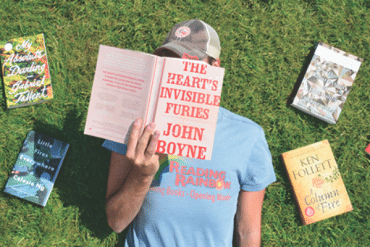 The Nantucket Wine Festival will pour through thousands of glass bottles this year, the bulk of which will be hauled off to the dump for recycling. some of these bottles, however, will become part of an art installation that promises to be truly smashing.
The Nantucket Wine Festival will pour through thousands of glass bottles this year, the bulk of which will be hauled off to the dump for recycling. some of these bottles, however, will become part of an art installation that promises to be truly smashing.
For someone who’s not much of drinker, local artist M.J. Levy Dickson knows wine, beer and liquor bottles better than most bartenders. She can tell you which labels peel off the easiest, which bottles run out the fastest, even which glass breaks into the most pieces. Dickson’s fascination has little to do with the bot- tles’ contents, but rather the bottles themselves. For when she peels off their labels, smashes them to pieces, and then runs the shards of glass through a cement mixer, what comes out the other end is a work of art she calls “Like Sea Glass: A Hand Full of Light.”
This summer, ten thousand pieces of Dickson’s handmade sea glass will stretch fifty feet through Pumpkin Pond Farm. “It will be an interactive landscape composed of large hand-molded glass shapes inspired by the sea,” the artist explains, pointing to a watercolor sketch of the design. “There will be a sand path meandering through the center of the glass landscape with a boardwalk rhythmically following its curve.” Unlike most art installations that are strictly for viewing, Dickson’s work is as much about touching as it is seeing. In fact, she encourages people to take a piece or two of glass home with them.
As the first artist-in-residence at the Perkins School for the Blind, Dickson developed a curriculum around tactile art, artwork that is expressed and experienced through touch. “Nothing is real to a person with limited vision unless he or she can touch and feel it,” she says. “For instance, most art teachers describe clouds as looking like cotton balls, but to a blind person this would be a misguided description.” She continues, “An atomizer spraying mist into the air would be more accurate as the blind person could feel the mist and realize clouds hold moisture and understand that rain comes from clouds.” Dickson hopes that her Pumpkin Pond Farm installation will merge tactile and visual arts, thus expanding upon the senses by which people experience her work.
“Here, try this,” she says, handing me a long piece of blue glass, “just close your eyes and feel it.” The glass is smooth, enjoyable to roll around in my palm, and feels a lot like a spoon. “I’ve shared this piece with two people, one in Massachusetts and one in London” she says.“Both have said it feels like a spoon.” At first, this revelation seems hardly profound. Yet when considered in the context of art and the appreciation of art, the thought begins to take shape. This piece of glass invokes a distinct image and emotion in the same way that an abstract painting can. In that light, these pieces of glass become like paints on a canvas, conveying images and experiences that transcend simply being a heap of broken bottles.
Almost as interesting as Dickson’s inspiration behind the project was her process in creating it. At last year’s Wine Festival, she sifted through the festival’s outgoing recycling looking for the right color glass, often to the mortification of her children. This went on for months, digging through the recycling bins of restaurants and bars. Then came the tedious prep-work of peeling off hundreds of labels. “I have a relationship with certain bottles because their labels were easy to get off,” she says, showing me a book full of labels like pressed flowers. “These were ones that came off the easiest.” The last step was to turn the shards of sharp glass into smooth sea glass. She called up Toscana Construction and they began experimenting tumbling glass in a cement mixer with a concoction of water, salt and other minerals. After much trial and error, Dickson was left with an estimated 10,000 pieces of smooth sea glass. These were then joined by handmade pieces created with the help of local glass designers, Katherine Moore and Allison MacDonald.
For some, Dickson’s installation might be hard to grasp. What’s so great about a huge pile of glass, anyway? Is it really art? To this, she responds by pointing to one of her chief inspirations, Chinese artist Ai Weiwei. Dickson visited Ai’s “Sunflower Seeds” installation at the Tate Modern in London, in which the artist displayed one hundred million hand-painted porcelain sunflower seeds. The artwork took years to create, with 1,600 artisans molding, sculpting and painting each of the hundred million seeds. The installation was widely praised and the Tate ultimately purchased the ten tons of seeds for its permanent collection. “The creation of one hundred million porcelain seeds serves as a reminder that together we have the ability to achieve our goals to everyone’s mutual benefit,” Dickson says, “we are only limited by our own imaginations.”





